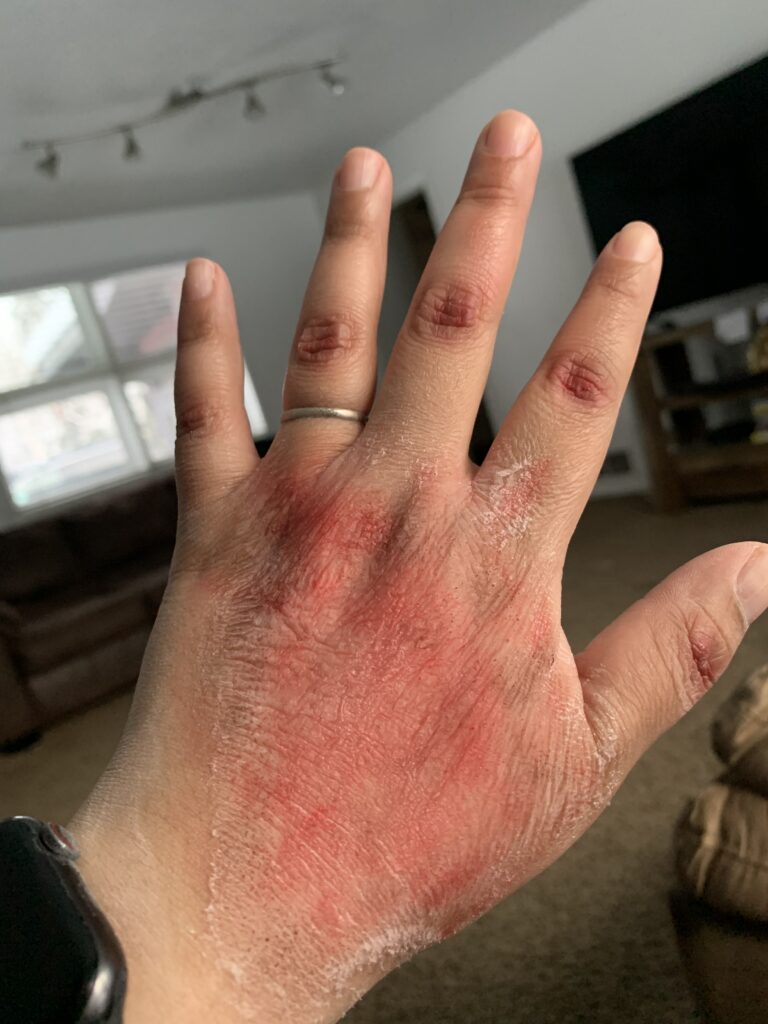
For my STEAM project, the learning objective that I will be focusing on is describing the functions of the integumentary. Additionally, I will also be discussing the chronic skin disorder of eczema.
The integumentary system is comprised of the skin and its accessory structures. The skin is the largest organ in the body and makes up about 16 percent of the body’s total weight. The skin needs daily care and protection in order to preserve its health.
Eczema, also known as atopic dermatitis, is a non-contagious skin disorder where the skin usually becomes dry, itchy, flaky, inflamed, and painful, and in severe cases bleeding can occur. It affects an estimated 30 percent of the U.S. population and is more prominently seen in children and adolescents.
The development of eczema is thought be caused by a combination of genetic and environmental factors, often correlated with other allergic diseases such as asthma, seasonal allergies, and food allergies. Children whose parents have asthma and allergies are more at risk to develop eczema.
The complications associated with eczema relate to the skin barrier being compromised. As we had stated in the beginning, our skin is the first barrier of protection from the outside environment. Those who suffer from eczema lack infection-fighting proteins making them more susceptible to bacterial, virus, and fungal skin infections.
An estimated 60-90 percent of people with atopic dermatitis likely to contract staph bacteria on their skin, eventually developing into infection. Viral infections such as herpes simplex virus is also a major risk.
So, what is the role of the skin? Its functions include:
- Holding in all the body’s inner organs
- First line of defense against pathogens, UV light, chemicals, and mechanical injury.
- Preserves the body’s homeostasis
- Serves to regulate temperature
- Acts as a barrier to water and regulates the amount of water the body releases into the environment
- The skin also contains numerous sensory, autonomic, and sympathetic nerve fibers that communicate to and from the brain
- Enabling us to feel
Individuals who have eczema, if mild enough should be able to take care of their reactions and even reduce reoccurrence of eczema flares at home.
- Keeping the skin moisturized
- Using moisturizers and petroleum jelly to lubricate skin
- Avoiding scratching
- Use of topical steroids
- Antihistamines for severe itching
- Avoiding skin care, including soaps, shampoos, and detergents, that contain irritating ingredients such:
- Alcohols
- Dyes
- Fragrance
- Other irritating ingredients
- Use of humidifiers, especially if living in drier climates
- Avoiding long showers and baths
- Should have lukewarm for bath or showers (avoid hot water)
- Using occlusive moisturizers or petroleum jelly on body or affected areas right after bathing to still damp skin to lock in hydration and prevent water loss
- Also, after handwashing – as hand hygiene has become more frequent practice due to the outbreak of COVID-19, hand eczema has become more common.
- Study of hand hygiene show that risk of eczema flare from frequent hand washing was higher than using alcohol-based hand sanitizer.
- Also, after handwashing – as hand hygiene has become more frequent practice due to the outbreak of COVID-19, hand eczema has become more common.
- Avoiding or minimizing triggers such as pollen, mold, dust mites, animal and food allergies
- Avoiding stress (as much as possible)
If eczema condition is new onset, do not improve, or get worse, it is always important to seek medical advice.
Works Cited
“Eczema (Atopic Dermatitis).” National Institute of Allergy and Infectious Diseases, U.S.
Department of Health and Human Services, 19 Apr. 2017, https://www.ncbi.nlm.nih.gov/books/NBK470464/
Loh, Enver De Wei, and Yik Weng Yew. “Hand Hygiene and Hand Eczema: A Systematic Review and Meta-Analysis.” Contact Dermatitis, vol. 87, no. 4, Oct. 2022, pp. 303-14. EBSCOhost, https://doi.org/10.1111/cod.14133
Yousef, Hani, et al. “Eczema (Atopic Dermatitis).” National Institute of Allergy and Infectious Diseases, U.S. Department of Health and Human Services, 19 Nov. 2021, https://www.niaid.nih.gov/diseases-conditions/eczema-atopic-dermatitis

Hi Martha,
Great project, I have been curious about eczema myself so this helped answer some questions I had. Overall, it looks like you did a good job typing in skin to your project as we had learned about before in class and then also adding a new concept, eczema, for people to learn further about. The statistic you used that around 30 percent of people in the U.S. have some degree of eczema is interesting because it seems like a large number. In the smaller cases when keeping your skin moisturized is good and also using a humidifier so the air isn’t as dry. However, I did not realize that people with eczema lack infection fighting proteins that defend from illness that gets in the skin. Great job on the project, I found it fascinating.
Hi Martha! I really loved your project and it was actually really fun to read. You presented us with the facts about eczema and showed us the functions of the skin and then moved on to tell us the effects and methods to curing and preventing this skin disorder. Something I haven’t ever taken into consideration was that eczema can develop through the combination of genetic and environmental factors and other diseases like asthma, seasonal and food allergies. You did a great job with the format of your words and delivery of the information on this topic and made it intriguing and interesting. It’s nice knowing the bases of what you’ll be talking about at the start and then having all that great information in between. I loved this project and you did an amazing job!
Thank you, Nathan.